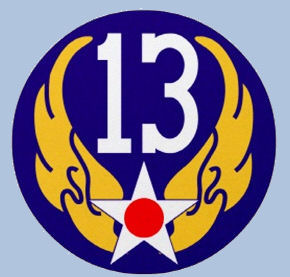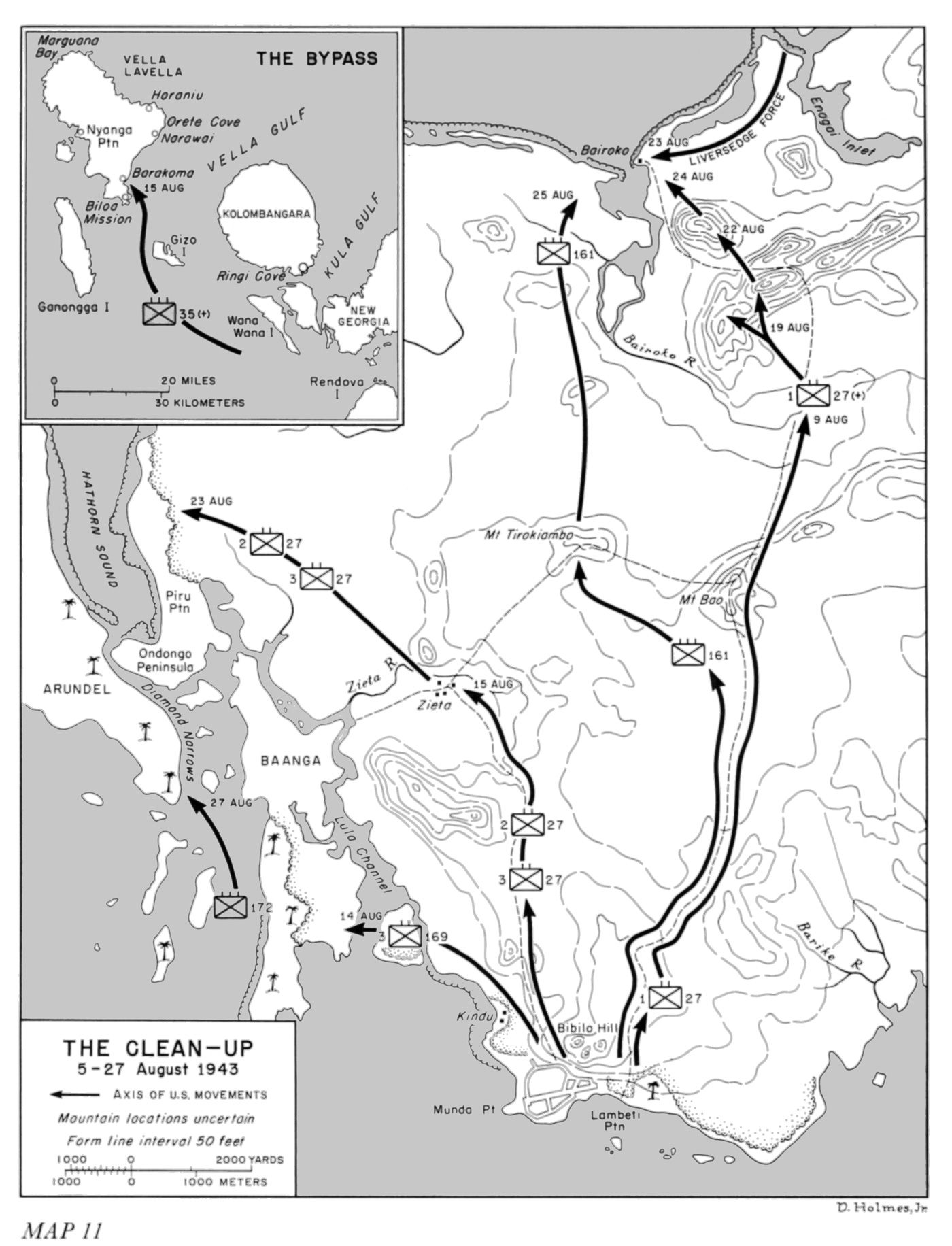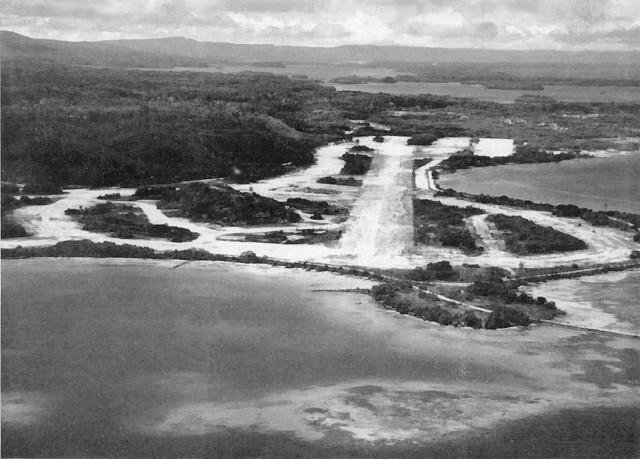|
Segi Point Airfield
Segi Point Airfield is a former World War II airfield on New Georgia in the Solomon Islands archipelago. History World War II The Segi (Seghe) Point area was the base of the British Commonwealth coastwatcher, Donald Gilbert Kennedy, who had monitored Japanese shipping and aircraft (reporting by radio) and also rescued American airman who were shot down in the territory held by the Japanese. In May and June 1943 Japanese patrols moved into the Segi Point area. The Segi Point area was secured by the 4th Marine Raider Battalion on 30 June 1943 in the opening phase of the New Georgia Campaign. The 20th, 24th and 47th Naval Construction Battalions landed with the Marines and immediately began construction of a fighter airstrip. Bad weather and poor soil conditions delayed construction, but by 18 July a coral-surfaced by runway was ready for use. By the end of July taxiways and revetments had been completed. In August the runway was widened to and two gas tanks had been constructe ... [...More Info...] [...Related Items...] OR: [Wikipedia] [Google] [Baidu] |
New Georgia
New Georgia, with an area of , is the largest of the islands in Western Province, Solomon Islands, and the 200th-largest island in the world. Geography New Georgia island is located in the New Georgia Group, an archipelago including most of the other larger islands in the province. The island measures approximately long by wide. New Georgia forms part of the southern boundary of the New Georgia Sound. Kolombangara lies across the Kula Gulf to the west, Choiseul to the northeast, Vangunu is to the southeast, and Rendova to the southwest, across the Blanche Channel. New Georgia is a volcanic island, surrounded in some places by a coral reef. The highest point is Mount Masse, with an elevation of . The climate is wet and tropical, and the island is subject to frequent cyclones. New Georgia is covered with dense vegetation, in the marshy areas mangroves are located. Population The population of the island was 19,312 in 1999. Most of the population resides on the south coa ... [...More Info...] [...Related Items...] OR: [Wikipedia] [Google] [Baidu] |
Douglas SBD Dauntless
The Douglas SBD Dauntless is a World War II American naval scout plane and dive bomber that was manufactured by Douglas Aircraft from 1940 through 1944. The SBD ("Scout Bomber Douglas") was the United States Navy's main carrier-based scout/dive bomber from mid-1940 through mid-1944. The SBD was also flown by the United States Marine Corps, both from land air bases and aircraft carriers. The SBD is best remembered as the bomber that delivered the fatal blows to the Japanese carriers at the Battle of Midway in June 1942.Parker, Dana T. ''Building Victory: Aircraft Manufacturing in the Los Angeles Area in World War II,'' pp. 25–34, Cypress, CA, 2013. . The type earned its nickname "Slow But Deadly" (from its SBD initials) during this period. During its combat service, the SBD proved to be an excellent naval scout plane and dive bomber. It possessed long range, good handling characteristics, maneuverability, potent bomb load, great diving characteristics from the perforated dive ... [...More Info...] [...Related Items...] OR: [Wikipedia] [Google] [Baidu] |
Airfields Of The United States Army Air Forces In The Pacific Ocean Theatre Of World War II
An aerodrome (Commonwealth English) or airdrome (American English) is a location from which aircraft flight operations take place, regardless of whether they involve air cargo, passengers, or neither, and regardless of whether it is for public or private use. Aerodromes include small general aviation airfields, large commercial airports, and military air bases. The term ''airport'' may imply a certain stature (having satisfied certain certification criteria or regulatory requirements) that not all aerodromes may have achieved. That means that all airports are aerodromes, but not all aerodromes are airports. Usage of the term "aerodrome" remains more common in Ireland and Commonwealth nations, and is conversely almost unknown in American English, where the term "airport" is applied almost exclusively. A water aerodrome is an area of open water used regularly by seaplanes, floatplanes or amphibious aircraft for landing and taking off. In formal terminology, as defined by the I ... [...More Info...] [...Related Items...] OR: [Wikipedia] [Google] [Baidu] |
Airfields Of The United States Navy
An aerodrome (Commonwealth English) or airdrome (American English) is a location from which aircraft flight operations take place, regardless of whether they involve air cargo, passengers, or neither, and regardless of whether it is for public or private use. Aerodromes include small general aviation airfields, large commercial airports, and military air bases. The term ''airport'' may imply a certain stature (having satisfied certain certification criteria or regulatory requirements) that not all aerodromes may have achieved. That means that all airports are aerodromes, but not all aerodromes are airports. Usage of the term "aerodrome" remains more common in Ireland and Commonwealth nations, and is conversely almost unknown in American English, where the term "airport" is applied almost exclusively. A water aerodrome is an area of open water used regularly by seaplanes, floatplanes or amphibious aircraft for landing and taking off. In formal terminology, as defined by the ... [...More Info...] [...Related Items...] OR: [Wikipedia] [Google] [Baidu] |
United States Army Air Forces In The South Pacific Area
During World War II, the United States Army Air Forces engaged in combat against the Empire of Japan in the South Pacific Area. As defined by the War Department, this consisted of the Pacific Ocean areas which lay south of the Equator between longitude 159° East and 110° West. It included New Zealand, New Caledonia, New Hebrides, Fiji, and most of the Solomon Islands. In early 1942, the area was under the Seventh Air Force. By November, the Thirteenth Air Force, was formed to command and control AAF organizations in the southern areas of the widely separated Seventh Air Force and independent units scattered in the South Pacific Area during the Solomon Islands campaign. As the war progressed, Thirteenth Air Force units moved into the South West Pacific theatre and coordinated their activities with Fifth as part of the Far East Air Forces, a new formation. Airfields and unit assignments COOK ISLANDS * Amuri Field, Aitutaki Island, Cook Islands : * Robinson (Omoka) Field ... [...More Info...] [...Related Items...] OR: [Wikipedia] [Google] [Baidu] |
Ondonga Airfield
Ondonga Airfield is a former World War II airfield on New Georgia in the Solomon Islands archipelago. History World War II The Munda Point area was secured on 5 August 1943. While the rehabilitation and expansion of Munda Point Airfield was the first priority for the Seebees, the 37th and 82nd Naval Construction Battalions soon began building another fighter airfield on Ondonga Island across from Munda Point. Construction proceeded with difficulty as the island was covered with dense jungle over bog and the site was periodically shelled by Japanese artillery on Kolombangara Island and bombed by Japanese aircraft flying from Bougainville. After 25 days the Seebees had completed a coral-surfaced by fighter runway. By February 1944 the Seebees had completed a second parallel runway, roads, taxiways, hardstands, a control tower and a 12,000 barrel tank farm. Royal New Zealand Air Force units based at Ondonga included: * 14 Squadron operating P-40 Kittyhawks from November–Dec ... [...More Info...] [...Related Items...] OR: [Wikipedia] [Google] [Baidu] |
Munda Airport
Munda Airport is an international airport adjacent to the town of Munda, Western Province in Solomon Islands. Originally built by Japanese forces during World War II and further developed by the U. S. Naval Construction Battalions 24 and 73 following its capture. After the war, the airfield became a commercial airport for regional flights. In 2015, a New Zealand government aid and development project significantly upgraded the field to an international airporThe upgrade included the removal of a large amount of unexploded ordnance left behind by vacating Japanese and US forces. Although there were no international flights scheduled by 2019, the main economic purpose of the upgrade is to serve as an alternate field for international flights to Honiara International Airport, significantly reducing the fuel load and improving the economics of the flight. For example, prior to the Munda upgrade, a flight from Brisbane to Honiara had to carry sufficient fuel to return to Brisbane ... [...More Info...] [...Related Items...] OR: [Wikipedia] [Google] [Baidu] |
Barakoma Airfield
Barakoma Airfield is a former World War II airfield on Vella Lavella in the Solomon Islands archipelago. History World War II The U.S. 35th Infantry Regiment landed on Vella Lavella on 15 August 1943 as part of the Solomon Islands campaign. The 58th Naval Construction Battalions landed with the Army and began building support facilities despite frequent Japanese air attacks. In August 1943 the Seebees surveyed and cleared a site for an airfield and began building a coral-surfaced by fighter runway. Airfield facilities such as a signal tower, operations room, aviation-gasoline tanks, and camp for operating personnel, were completed in September and the first landing was made on 24 September. By November 1943 an aviation-gasoline tank farm of six 1,000-barrel tanks, with a sea-loading line was operational. US Navy units based at Barakoma included: *VF-40 operating F6Fs USMC units based at Barakoma included: *VMF-212 operating F4Fs *VMF-214 operating F4Us *VMF-215 operating ... [...More Info...] [...Related Items...] OR: [Wikipedia] [Google] [Baidu] |
Seghe Airport
Seghe Airport is an airport on Seghe in the Solomon Islands . The Segi Point area was secured by the 4th Marine Raider Battalion on 30 June 1943 in the opening phase of the New Georgia Campaign. The 47th Naval Construction Battalion (Seabees) landed with the Marines and immediately began construction of a fighter airstrip. Bad weather and poor soil conditions delayed construction, but by 18 July a coral-surfaced by runway was ready for use. By the end of July taxiways and revetments had been completed. In August the runway was widened to and two gas tanks had been constructed and by September 52 hardstands had been completed. The field was then used as a fighter strip to support the Rendova and Munda Point Landings. USAAF units based at Segi Point included: * 44th Pursuit Squadron operating P-40s US Navy units based at Segi Point included: * VB-305 operating SBDs *VF-33 operating F6Fs * VF-38 operating F6Fs *VF-40 Fighter Squadron 40 or VF-40 was an aviation unit ... [...More Info...] [...Related Items...] OR: [Wikipedia] [Google] [Baidu] |
VF-40
Fighter Squadron 40 or VF-40 was an aviation unit of the United States Navy. Originally established on 15 June 1943, it was disestablished on 19 November 1945. It was the only US Navy squadron to be designated as VF-40. Operational history VF-40 equipped with the F6F Hellcat supported the New Georgia Campaign deploying to Henderson Field on Guadalcanal in September 1943. While deployed in the Solomon Islands during 1943, VF-40 shot down 4 Japanese aircraft. VF-40 later supported the Borneo campaign (1945). See also *History of the United States Navy *List of inactive United States Navy aircraft squadrons *List of United States Navy aircraft squadrons *Espiritu Santo Naval Base Naval Advance Base Espiritu Santo or Naval Base Espiritu Santo, most often just called ''Espiritu Santo'', was a major advance Naval base that the U.S. Navy Seabees built during World War II to support the Allied effort in the Pacific. The base ... References {{DEFAULTSORT:VF-40 Strike fighter s ... [...More Info...] [...Related Items...] OR: [Wikipedia] [Google] [Baidu] |
VF-38
Fighter Squadron 38 or VF-38 was an aviation unit of the United States Navy. Originally established on 20 June 1943, it was disestablished on 31 January 1946. It was the only US Navy squadron to be designated as VF-38. Operational history VF-38 equipped with the F6F Hellcat supported the New Georgia Campaign deploying to Henderson Field on Guadalcanal in September 1943. While deployed in the Solomon Islands during 1943 VF-38 shot down 7 Japanese aircraft. See also *History of the United States Navy *List of inactive United States Navy aircraft squadrons *List of United States Navy aircraft squadrons This is a list of active United States Navy aircraft squadrons. ''Deactivated'' or ''disestablished'' squadrons are listed in the List of inactive United States Navy aircraft squadrons. Navy aircraft squadron (aviation), squadrons are composed of ... References Strike fighter squadrons of the United States Navy {{US-navy-stub ... [...More Info...] [...Related Items...] OR: [Wikipedia] [Google] [Baidu] |
Grumman F6F Hellcat
The Grumman F6F Hellcat is an American Carrier-based aircraft, carrier-based fighter aircraft of World War II. Designed to replace the earlier Grumman F4F Wildcat, F4F Wildcat and to counter the Japanese Mitsubishi A6M Zero, it was the United States Navy's dominant fighter in the second half of the Pacific War. In gaining that role, it prevailed over its faster competitor, the Vought F4U Corsair, which initially had problems with visibility and carrier landings. Powered by a Pratt & Whitney R-2800 Double Wasp, the same powerplant used for both the Corsair and the United States Army Air Forces (USAAF) Republic P-47 Thunderbolt fighters, the F6F was an entirely new design, but it still resembled the Wildcat in many ways. Some military observers tagged the Hellcat as the "Wildcat's big brother".Sullivan 1979, p. 4. The F6F made its combat debut in September 1943. It subsequently established itself as a rugged, well-designed carrier fighter, which was able to outperform the A6M Zer ... [...More Info...] [...Related Items...] OR: [Wikipedia] [Google] [Baidu] |









